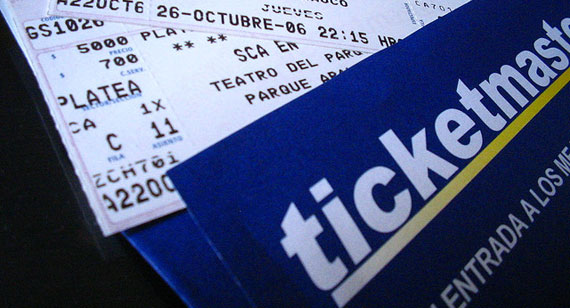Calculating the Face Value of a Concert Ticket

While it’s an understandable statement to make that “ticket prices are far too expensive nowadays”, what people really mean when they say things like that is usually not anything to do with how small promoters are swindling attendees at Open Mic Nights. It is still possible in most parts of North America and Europe to attend a small show for the approximate cost of a McDonald’s meal, even if said event is poorly attended and promoted far worse.
No, what music fans are really kicking and screaming about is the cost of major music events and shows. At a time when the concert industry seems gushing with cash, many people wonder why consumers are being burdened with more of the costs associated with the inherent risks of the industry. The concert business grossed a record $5.1 billion in North America last year, according to a new analysis from trade publication Pollstar, thanks to near-record prices and a colossal number of shows by major acts. Plus, the demand for live music has never been higher.
While ticket costs may have remained stable over 2013, with prices only seeing a small 1% increase from 2012, most agree that it should be cheaper than the average amount paid by the consumer: $69.52 per ticket.
There’s good reason to think that little change will come. Especially when looking at some of the testimonies in 2009 during the hearing over whether Ticketmaster and Live Nation could merge their business. Live Nation CEO, Michael Rapino, had much to say regarding the stereotype that music industry grandees such as himself were making easy money.
“Every time a consumer walks in the door I make about $12-$14 on the ancillary business,” Rapino testified. “I lose $80 million at the door [annually]. An average promoter, if he’s lucky, makes about $4 out of every $100 on the ticket price.”
He’s not wrong either. Just because Live Nation buys Justin Bieber’s latest tour on which thousands of young girls will no doubt flock, there’s still no guarantee of big bucks in today’s music industry ecology. Since most people who hear Justin’s music won’t of ever directly paid for it (much like every other poor soul in the industry) then a clever Justin will no doubt look into generating some alternative revenue elsewhere. The general consensus in this area, as you’ve no doubt guessed, is that touring is the best way to make up this shortfall in music sales. It’s a win/win situation: Justin gets to keep his Lamborghini and Miami mansion and the fans are much more likely to see their hero in person. Sure, Justin has to spend a couple more months of the year logging tour dates, but such is the price of modernity.
The promoters, crushed by the plummeting music sales, are forced to put up much more comfortable up-front guarantees (a set sum or percentage of ticket sales) to convince the artist, their team and label that they’ll definitely be making some money out of the whole enterprise. Competition could be stiff for some of the biggest earning performers, so you’d better be prepared to offer a pretty cozy up-front figure. Remember, everyone else is trying to make money too. After the cost of the shows and the healthy sum of money guaranteed to the performer, the promoter often has little more than sales of merchandise – or as Rapino, CEO of Live Nation, puts it: “the ancillary business”.
There are other factors impacting how much you pay for your night of live music too. If you’re a teenager (or somebody who likes ‘music for teenagers’) expect to pay the same price as an adult. The instinct of a promoter dictates that your ticket is probably being paid for by an adult with a full-time job who will purchase your ticket regardless of the price (within reason). In this case, dropping ticket prices to take into account the age of people attending would make little financial sense for a tour that will probably sell out anyway. Sorry, no discounts for you.
If you’re a retromaniac and long for the day when you can see your youth relived in a live set by your favorite band, unlucky. Nostalgia is costly and you could be paying triple figures depending on how big your idol(s) are and how long you’ve been waiting. Seeing a relatively active veteran, regardless of whether or not they’ve recently undone their disappearing act, will still set you back a fair bit. There’s a reason why 2012’s biggest takers in live music were all in some way a member of music’s old guard. Madonna topped it, with $134 million in ticket sales, followed by Cirque du Soleil’s tribute to Michael Jackson, “The Immortal,” which had $113 million; Bruce Springsteen was No. 3 with $105 million.
But even with some of the cold calculations made by the big music promoters, don’t expect the face value of tickets to tumble to an acceptable level even when we remove these nuances. The picture might be improving but we’re unlikely to see a change in prices until the concert industry sees continued improvement. Live Nation, the world’s biggest concert promoter, had $6.5 billion in revenue in 2013, compared with $5.8 billion the year before. Sound good? Overall, it had a net loss of $36 million. Better than the $162 million loss in 2012 though. It seems we still have some ways to go.

Those are bogus numbers for the top acts on the road. Look at ticket prices from the Zac Brown Band to Fleetwood Mac and you’ll see the prices are up 30% or more from just a couple of years ago. And that does’t take into account the number of seats pulled for Platinum and VIP seating which are often 300% or more than the face value tickets.